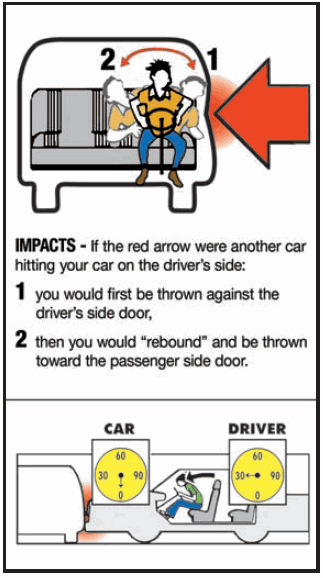Did you know that some driving laws in California apply to occupants and passengers? If you are a passenger in a vehicle within the state of California, here are the rules you need to follow.
Passenger Seat Belt Laws In California
Seat belts, both the lap belt and shoulder harness, must be in good working order. You may not operate your vehicle on public roads and on private property, such as public parking lots, unless you and all of your passengers eight years of age or older, or children who are 4 feet 9 inches tall or taller are wearing seat belts; and children younger than eight years old or who are less than 4 feet 9 inches tall are seated in a federally-approved child passenger restraint system. You and all passengers must wear a seat belt or, you and/or your passenger(s) may be cited. If the passenger is under 16 years of age, you may be cited if he or she is not wearing his or her seat belt.
Always use your seat belts (including the shoulder harness) even if the vehicle is equipped with air bags. You can have shoulder harnesses or seat belts installed in older vehicles. Even if you wear only a lap belt when driving, your chances of living through a collision are twice as high as someone who does not wear a lap belt. If you wear a lap and shoulder belt, your chances are three to four times higher to live through a collision.
Pregnant women should wear the lap belt as low as possible under the abdomen, and the shoulder strap should be placed between the breasts and to the side of the abdomen’s bulge.
WARNING: Using seat belts reduces the risk of being thrown from your vehicle in a collision. If you do not install and use a shoulder harness with the seat (lap) belt, serious or fatal injuries may happen in some collisions. Lap-only belts increase the chance of spinal column and abdominal injuries—especially in children. Shoulder harnesses may be available for your vehicle, if it is not already equipped with them.
Mistaken Beliefs About Seat Belts
Many studies and actual crash tests have proven safety belts can reduce injuries and deaths. Have you heard these myths?
MYTH: “Seat belts can trap you inside a vehicle.” Research shows it actually takes less than a second to take off a seat belt. This myth often describes a vehicle that caught fire or sank in deep water. A seat belt may keep you from being “knocked out.” Therefore, your chances to escape are better if you are conscious
MYTH: “Seat belts are good on long trips, but I don’t need them if I’m driving around town.” More than half of all traffic deaths happen within 25 miles of home. Do not take chances with your life or the lives of your passengers. Buckle up every time you drive regardless of travel distance.
MYTH: “Some people are thrown from a vehicle in a crash and walk away with hardly a scratch.” Research shows your chances of surviving a collision are five times better if, upon impact, you are not thrown from the vehicle. A seat belt can keep you from being thrown into the path of another vehicle.
MYTH: “I’m only going to the store. My little brother or sister doesn’t need to be secured in a safety seat.” Research shows car collisions are the number one preventable cause of death for children. The law requires that children under eight years of age who are 4 feet 9 inches tall or taller to be properly secured with an appropriate safety belt or be buckled into a federally-approved child passenger restraint system if under eight years of age and less than 4 feet 9 inches tall.
The following graphic illustrates what can happen in a collision. If you are struck from the side, the impact could push you back and forth across the seat. Seat belts and shoulder harnesses keep you in a better position to control the vehicle and may minimize serious injuries.
When you collide, your vehicle stops, but you keep going at the same speed you were traveling, until you hit the dashboard or windshield. At 30 miles per hour (mph) this motion is equivalent to hitting the ground from the top of a three-story building.

California Laws Regarding Child Restraint System and Safety Seats
Any child who is under eight (8) years old must be secured in a federally-approved child passenger restraint system and ride in the back seat of a vehicle.
EXCEPTION: A child who is under eight (8) years old and who is at least 4 feet 9 inches tall may instead use a properly secured seatbelt.
A child who is under eight (8) years old may ride in the front seat of a vehicle in the following instances:
- There is no rear seat or the rear seats are either side-facing jump seats or rear-facing seats.
- The child passenger restraint system cannot be properly installed in the rear seat.
- All rear seats are already occupied by children under the age of seven (7) years.
- A medical reason requires the child to ride in the front seat.
A child may not ride in the front seat of an airbag-equipped vehicle if the child:
- Is less than one (1) year of age.
- Weighs less than 20 lbs.
- Is riding in a rear-facing child passenger restraint system.
Children eight (8) years of age and older, but under 16 years old must be properly secured with an appropriate seatbelt.
Proper child passenger restraint system installation can be checked by contacting local law enforcement agencies or fire departments that may provide this service or refer you to a child passenger safety technician in your area. As your child grows, check with these agencies to confirm that the car seat is the correct size for your child.
California Air Bag Regulations
Most people can take steps to eliminate or reduce air bag risk without turning off air bags. The biggest risk is being too close to the air bag. An air bag needs about 10 inches of space to inflate. Ride at least 10 inches (measured from the center of the steering wheel to your breastbone) from the air bag cover, if you can do this while maintaining full control of the vehicle. If you cannot safely sit 10 inches away from the air bag, contact your vehicle dealer or manufacturer for advice about additional ways of moving back from your air bag.
Passengers should also sit at least 10 inches away from the passengerside air bag.
Side-Impact Air Bags
Side-impact air bags can provide extra safety benefits to adults in side-impact crashes. However, children who are seated next to a side air bag may be at risk of serious or fatal injury. Since side air bags are different in design and performance, you should consider the benefits and risks associated with the use of side air bags if you transport children. Studies have shown that children who are leaning against a side air bag when it inflates are at risk of serious injury. These studies also show that children who are traveling in a correctly installed child restraint system appropriate to age and weight are not at risk of serious injury. These children are usually not in the path of a side air bag when it inflates.
California Laws Regarding Unattended Children In Motor Vehicles
It is never a good idea to leave a child unattended in a vehicle.
It is illegal to leave a child six years or younger unattended in a motor vehicle.
The court may fine a violator and require him or her to attend a community education program. Also, DMV and court penalties for leaving an unattended child in a vehicle are more severe if the child is injured, requires emergency medical services, or dies.
NOTE: The child may be left under the supervision of a person 12 years of age or older.
Hot Weather Risks
As stated in the “Unattended Children in Motor Vehicles” section above, it is against the law to leave unattended minor children in a vehicle (CVC §5620). Additionally, and equally important, it is dangerous and deadly to leave children and/or animals in a hot vehicle. After sitting in the sun, even if a window is slightly opened, the temperature can rise rapidly inside a parked vehicle. The temperature inside a vehicle can rise approximately 40-50 degrees higher than the outside temperature.
Dehydration, heat stroke, and death can result from overexposure to the heat. Remember if it’s too hot for you, it’s too hot for children and pets.
